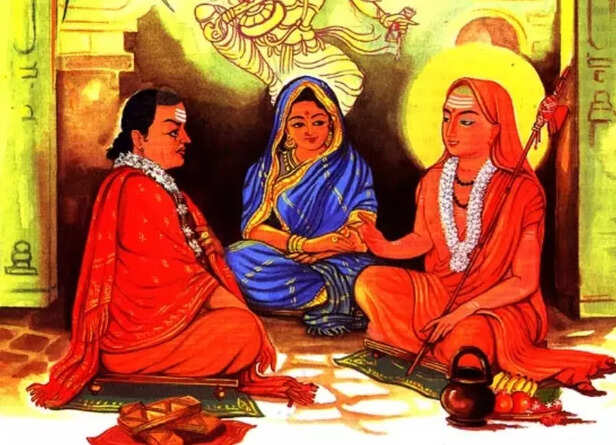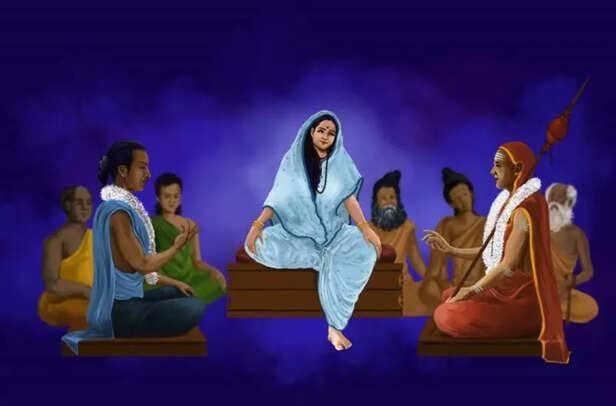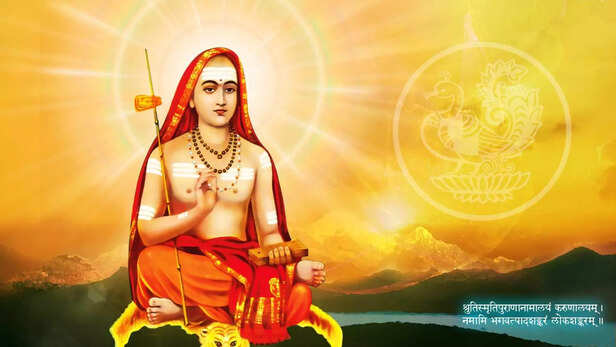The Ultimate Technique of Shankaracharya—When the Sage Became the King
Ankit Gupta | Apr 12, 2025, 13:41 IST
The Siddha Kunjika Stotra is a profound and powerful mantra revealed in a conversation between Devi and Mahadev, as described in the RudraYamala Tantra. The conversation unveils three crucial secrets that anyone wishing to chant this stotra must understand:
"न शून्यं न च शाश्वतं नैव जीवं न मृतं ततः |
एकमेव अद्वितीयं ब्रह्म, सर्वानुभव-साक्षिकम् ||"
– “It is neither void nor eternal, neither living nor dead. The One and Only Non-dual Brahman is known through all experience.”
In the hallowed timeline of Bharat's spiritual history, few figures shine brighter than Adi Shankaracharya—the master of Advaita Vedanta, the lion of logic, the poet of non-duality. But even the greatest of spiritual warriors encounter challenges that test the very fabric of their realization. For Shankaracharya, one such test came not just in the form of debate—but in the form of life itself. The tale of his encounter with Mandan Mishra and Ubhaya Bharati is not just a clash of philosophies. It is the moment when Shankaracharya invoked his ultimate technique—Para Kaya Pravesha—to uphold the truth of Advaita and emerge victorious not through denial of the world, but by entering it fully and returning untouched.

In ancient India, the Mimamsa philosophy flourished—emphasizing ritual action, scriptural authority, and the primacy of Vedic karma. Its most formidable proponent was Mandan Mishra, a revered scholar and householder whose intellect had humbled many. When Shankaracharya came face to face with him, it was more than a scholarly debate—it was a cosmic collision between two visions of life.
Mandan Mishra, amused by the youthful Shankara, mocked:
"You, barely twenty, wish to challenge a lifelong scholar like me? I’ll let you choose your own judge!"
Unfazed, Shankaracharya chose Ubhaya Bharati, Mandan Mishra's wife, known for her razor-sharp intellect and mastery over scriptures.
The debate began.
Days turned into nights. Arguments flew like arrows in a battlefield of minds. Shankaracharya, with his deep insight into the Upanishads and fierce reasoning, slowly began to overpower Mandan Mishra. The tide turned. And as Mandan Mishra faltered, all eyes turned to Ubhaya Bharati.
But she wasn’t ready to concede just yet.

Ubhaya Bharati, the Ardhangini—the spiritual half of her husband—raised her voice,
"If I am part of my husband, and you have defeated him, then you must defeat me as well."
The audience gasped. A second round had begun, and this time, the battlefield was even more unpredictable.
Ubhaya Bharati had a secret weapon: she turned the debate toward the realm of marital relationships, sensuality, and household life—a domain a renunciate like Shankaracharya would naturally have no experience in.
And she was right.
Shankaracharya found himself at an impasse. A celibate sannyasi could not convincingly speak of grhastha dharma—the duties and dynamics of married life. To retreat now would be to accept defeat.
But Shankaracharya did not retreat.
He paused, bowed, and asked for one month to return with answers.

What followed is a tale that blurs the line between mysticism and miracle. Shankaracharya, using his yogic vision, discovered that a nearby king had just died from a snakebite. With a determined heart, he told his disciples:
"I shall enter the body of the deceased king. Guard my body until I return."
And then he did what only a true Siddha can.
Through the yogic power of Para Kaya Pravesha—literally, entering another’s body—Shankaracharya left his own and entered the corpse of the king. The lifeless monarch suddenly stood up, stunning the court and his queen. The kingdom rejoiced, believing their king had risen by divine grace.
But in truth, Shankara now lived inside a body immersed in royal luxury. He learned the ways of the world, observed the duties of a husband and king, and even engaged in deep discussion with the queen about love, companionship, and human relationships.
In that one month, Shankaracharya, though untouched by desire, absorbed the full spectrum of grhastha life. He saw the illusion without being caught in it.

After a month, Shankaracharya exited the king’s body and returned to his awaiting disciples. With newly-acquired insights—not second-hand knowledge, but lived understanding—he returned to the debate arena.
The second session began.
Now, Ubhaya Bharati’s questions met answers—clear, precise, and profound. Shankaracharya had transcended the line between renunciation and engagement. He had proved that the Ultimate Truth is beyond all roles—sannyasi or householder—and is accessible to those who truly seek it.
Ubhaya Bharati, the great scholar herself, finally conceded.
And so, Mandan Mishra became Shankaracharya’s disciple, eventually taking sannyasa and the name Sureshwaracharya. He went on to become the first head of the Sringeri Sharada Peetham, one of the four mathas established by Shankara across India.
This story is not just an adventure—it is a profound spiritual lesson.
Shankaracharya could have insisted that as a renunciate, he need not learn about worldly matters. But he chose Truth over Ego. He embodied the very Advaitic realization he preached:
“Brahman alone is real. The world is an appearance. The Self is nothing but Brahman.”
To enter the world and not be caught in it, to learn from it and yet remain beyond it, is the mark of a true Jivanmukta—a liberated being.
Para Kaya Pravesha here is not just a siddhi, it is a metaphor for our own spiritual journey:
The tale of Shankaracharya and Para Kaya Pravesha teaches us that the real sadhana (practice) is not withdrawal from life, but the ability to enter every experience with detachment and awareness.
That is what Shankaracharya did.
He didn’t just teach Advaita—he lived it, embodied it, and demonstrated it in every breath, debate, and silence.
And that is why, centuries later, his life still shines not just as a beacon of intellect—but as a living flame of non-dual realization.
एकमेव अद्वितीयं ब्रह्म, सर्वानुभव-साक्षिकम् ||"
– “It is neither void nor eternal, neither living nor dead. The One and Only Non-dual Brahman is known through all experience.”
In the hallowed timeline of Bharat's spiritual history, few figures shine brighter than Adi Shankaracharya—the master of Advaita Vedanta, the lion of logic, the poet of non-duality. But even the greatest of spiritual warriors encounter challenges that test the very fabric of their realization. For Shankaracharya, one such test came not just in the form of debate—but in the form of life itself. The tale of his encounter with Mandan Mishra and Ubhaya Bharati is not just a clash of philosophies. It is the moment when Shankaracharya invoked his ultimate technique—Para Kaya Pravesha—to uphold the truth of Advaita and emerge victorious not through denial of the world, but by entering it fully and returning untouched.
The Clash of Titans—Shankaracharya vs. Mandan Mishra

Adi Shankaracharya and Mandan Mishra
In ancient India, the Mimamsa philosophy flourished—emphasizing ritual action, scriptural authority, and the primacy of Vedic karma. Its most formidable proponent was Mandan Mishra, a revered scholar and householder whose intellect had humbled many. When Shankaracharya came face to face with him, it was more than a scholarly debate—it was a cosmic collision between two visions of life.
Mandan Mishra, amused by the youthful Shankara, mocked:
"You, barely twenty, wish to challenge a lifelong scholar like me? I’ll let you choose your own judge!"
Unfazed, Shankaracharya chose Ubhaya Bharati, Mandan Mishra's wife, known for her razor-sharp intellect and mastery over scriptures.
The debate began.
Days turned into nights. Arguments flew like arrows in a battlefield of minds. Shankaracharya, with his deep insight into the Upanishads and fierce reasoning, slowly began to overpower Mandan Mishra. The tide turned. And as Mandan Mishra faltered, all eyes turned to Ubhaya Bharati.
But she wasn’t ready to concede just yet.
The Feminine Fire—Ubhaya Bharati’s Challenge

Ubhaya Bharti - Mandana Mishra's Wife
Ubhaya Bharati, the Ardhangini—the spiritual half of her husband—raised her voice,
"If I am part of my husband, and you have defeated him, then you must defeat me as well."
The audience gasped. A second round had begun, and this time, the battlefield was even more unpredictable.
Ubhaya Bharati had a secret weapon: she turned the debate toward the realm of marital relationships, sensuality, and household life—a domain a renunciate like Shankaracharya would naturally have no experience in.
And she was right.
Shankaracharya found himself at an impasse. A celibate sannyasi could not convincingly speak of grhastha dharma—the duties and dynamics of married life. To retreat now would be to accept defeat.
But Shankaracharya did not retreat.
He paused, bowed, and asked for one month to return with answers.
Para Kaya Pravesha

Adi Shankaracharya
What followed is a tale that blurs the line between mysticism and miracle. Shankaracharya, using his yogic vision, discovered that a nearby king had just died from a snakebite. With a determined heart, he told his disciples:
"I shall enter the body of the deceased king. Guard my body until I return."
And then he did what only a true Siddha can.
Through the yogic power of Para Kaya Pravesha—literally, entering another’s body—Shankaracharya left his own and entered the corpse of the king. The lifeless monarch suddenly stood up, stunning the court and his queen. The kingdom rejoiced, believing their king had risen by divine grace.
But in truth, Shankara now lived inside a body immersed in royal luxury. He learned the ways of the world, observed the duties of a husband and king, and even engaged in deep discussion with the queen about love, companionship, and human relationships.
In that one month, Shankaracharya, though untouched by desire, absorbed the full spectrum of grhastha life. He saw the illusion without being caught in it.
The Final Victory with Wisdom

Final Debate
After a month, Shankaracharya exited the king’s body and returned to his awaiting disciples. With newly-acquired insights—not second-hand knowledge, but lived understanding—he returned to the debate arena.
The second session began.
Now, Ubhaya Bharati’s questions met answers—clear, precise, and profound. Shankaracharya had transcended the line between renunciation and engagement. He had proved that the Ultimate Truth is beyond all roles—sannyasi or householder—and is accessible to those who truly seek it.
Ubhaya Bharati, the great scholar herself, finally conceded.
And so, Mandan Mishra became Shankaracharya’s disciple, eventually taking sannyasa and the name Sureshwaracharya. He went on to become the first head of the Sringeri Sharada Peetham, one of the four mathas established by Shankara across India.
The Philosophical Message—Entering the World to Transcend It
Shankaracharya could have insisted that as a renunciate, he need not learn about worldly matters. But he chose Truth over Ego. He embodied the very Advaitic realization he preached:
“Brahman alone is real. The world is an appearance. The Self is nothing but Brahman.”
To enter the world and not be caught in it, to learn from it and yet remain beyond it, is the mark of a true Jivanmukta—a liberated being.
Para Kaya Pravesha here is not just a siddhi, it is a metaphor for our own spiritual journey:
- Can we step into difficult experiences without losing ourselves?
- Can we learn from the world without being bound by it?
- Can we see the self in all forms—and still remain rooted in the formless?
The Ultimate Technique Is the Ultimate Realization
That is what Shankaracharya did.
He didn’t just teach Advaita—he lived it, embodied it, and demonstrated it in every breath, debate, and silence.
And that is why, centuries later, his life still shines not just as a beacon of intellect—but as a living flame of non-dual realization.
